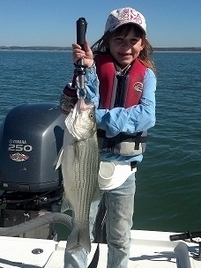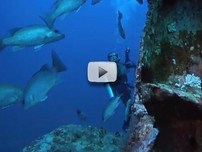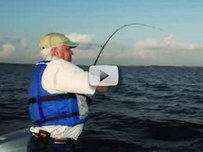In this issue:
Back to Top

You could be a contender. The Angler Recognition Program keeps fishing records by length, weight, species, method of catch, and water body. It recognizes one outstanding Catch of the Month, and even offers a First Fish Award for anglers of any age. See where the records stand.
When you’re out on the water with a big one, you can use our mobile web page to see how your latest catch measures up. (Bookmark it for when you get lucky.)
Local businesses are helping to grow a statewide network of Official Weigh Stations designed to make it easier for Texas anglers to find certified scales and submit their record catches. Find a weigh station near you here. Businesses wishing to become Official Weigh Station partners can learn more and sign up online.
|
Back to Top
 Please share this reminder with boaters who use shallow coastal areas. Please share this reminder with boaters who use shallow coastal areas.
Seagrasses provide the best habitat we have in the bays and are a key reason we maintain such good fish populations and good fishing. However, the increasing number of boats, along with their ability to access shallow areas is damaging this essential and sensitive habitat.
To protect this fragile resource, boaters should use their motor to get to saltwater flats, not through the flats. The best practice is to lift the motor when reaching a shallow area, then drift across seagrass meadows or use a pole or trolling motor. Thirty inches from the bottom will provide good clearance to minimize impact to seagrass beds.
Learn how to fish successfully along Texas coastal flats while preserving the seagrass beds in this video, “A Scar on the Flats.”
Boat propeller scars on an individual basis may seem minimal compared to other threats to seagrass, such as dredging or hurricanes, but when multiplied by the thousands, prop scars create serious impacts. These threats can be addressed by simply changing the way we boat in these shallow areas.
Besides seagrass protection, another big issue is looming on our shores — more and more people all trying to share the same space. Texas now has about 800,000 active saltwater anglers, 600,000 registered boats, and 74,000 duck hunters. These folks and others want to enjoy the coast in an increasing variety of ways. In 2012 the Coastal User Working Group, made up of recreational anglers and associated organizations, was formed to develop recommendations and to reduce user conflicts in Texas’ bays and estuaries. This group made nine recommendations to protect seagrass and five to reduce user conflict. Read the recommendations and report online.
Learn more about seagrass meadows on the TPWD website.
|
Back to Top
A message from a Texas Parks & Wildlife magazine advertiser

 If you like offshore fishing, you’ll love the Artificial Reef Program. On the flat, mostly featureless Gulf floor, de-commissioned drilling jackets (rigs), military vessels, and about a zillion tons of concrete in various forms create shelter and habitat that benefits some of your favorite recreational fish species. You could call it “recycling Texas-style.” If you like offshore fishing, you’ll love the Artificial Reef Program. On the flat, mostly featureless Gulf floor, de-commissioned drilling jackets (rigs), military vessels, and about a zillion tons of concrete in various forms create shelter and habitat that benefits some of your favorite recreational fish species. You could call it “recycling Texas-style.”
On the program’s new web area, an interactive map of reef locations helps anglers locate great fishing spots. You can also watch the USTS Texas Clipper begin its life as a reef, see how a rig gets reefed, and even get a glimpse at fish you could spot on a reef.
This site also helps corporations and communities get started in a partnership with Texas Parks and Wildlife. The program is entirely self-funded through corporate partnerships and grants.
The Artificial Reef Program uses environmentally-safe, durable materials to create underwater “planned communities” that benefit marine life, recreational and commercial fishing, and tourism in Texas’ coastal communities. Sites and materials are state and federally permitted (unauthorized ocean dumping is a prosecutable crime) and are located in water depths of 50-300 feet.
Watch this new video, "Office in the Ocean," to see what life is like for program staff members who study and monitor the reefs they help create.
“Like” the Artificial Reefs Facebook page to see videos and updates from program staff and scientific partners.
Go ahead. Dive in.
|
Back to Top
A message from a Texas Parks & Wildlife magazine advertiser
 

This year marks the 50th anniversary of Texas Parks and Wildlife Department, created by the 1963 merger of the Texas Game and Fish Commission and the State Parks Board. Since then, Texas has become a destination for anglers everywhere. The agency’s programs to protect and enhance fisheries, wildlife and habitat have led to more fishing spots, greater species diversity, bigger bass, and millions of happy freshwater and saltwater anglers. Here are some of the biggest milestones:
- 1965 – First rainbow trout stocked in the Guadalupe River, jump starting the southernmost year-round trout fishery in the nation.
-
1967 – First stocking of striped bass in Texas, the beginning of a major new recreational fishery for the state.
-
1981 – The Redfish Bill (HB 1000) designates red drum and spotted seatrout as game fish and prohibits their sale.
-
1986 – The ShareLunker Program begins; the first lunker comes from Lake Fork and weighs 17.65 pounds.
-
1992 – Restoration of native Guadalupe Bass, the state fish of Texas, gets underway in Texas fisheries.
-
1996 – The commercial shrimping license buy-back program begins to improve coastal game fish populations.
-
2005 - Protection of ecologically vital seagrasses increases on the Texas coast.
-
2012 - The new John D. Parker East Texas State Fish Hatchery in Jasper County opens and is expected to produce four to five million fish fingerlings.
Join the celebrating by sharing your great fishing photo or story that shows why “life’s better outside” in Texas. Many will be posted our web site, and a few could even become videos on our YouTube channel.
|
Back to Top


You may be surprised by this list of Texas’ top bass lakes. In a fishing survey conducted in the Fall of 2012, TPWD biologist Spencer Dumont used information collected from electrofishing over 4,800 adult bass (8 inches and longer) at 935 different shoreline sites from 62 reservoirs to rank the top bass populations.
Remember, if you catch a Largemouth Bass that weighs more than 13 pounds between October 1 and April 30, call our 24-hour pager at 1-888-784-0600 to donate it to the Toyota Sharelunker Program which aims to breed bigger bass for Texas.
|
Back to Top

Additional leased fishing access areas are open along the Brazos, Colorado, and Neches rivers just in time for spring fishing opportunities.
The new angler access areas on the Brazos River are located upstream of Waco and provide excellent fishing opportunities for smallmouth bass, largemouth bass, and catfish. Already a popular fishing destination among fly anglers that target largemouth bass, the Colorado River access area provides increased access for anglers downstream of Lady Bird Lake in Austin. The Neches River site provides access to the popular spring white bass run at the State Highway 31 bridge crossing immediately upstream of Lake Palestine.
Find directions to these new angler access areas and information on special use conditions on the TPWD River Fishing webpage. Find other freshwater and saltwater public access points where you can drop a line this spring at www.tpwd.state.tx.us/where.
These new leased fishing access areas were made possible with grant funding provided by the U.S. Department of Agriculture’s Voluntary Public Access and Habitat Incentive Program.
|
Back to Top
 About 84% of freshwater anglers fish lakes and reservoirs. But our reservoirs are aging and losing their fish habitats. Good habitat matters to all of us. Fish habitat is the foundation for healthy aquatic life and clean water supplies. The water fish live in is the same water you drink. What’s good for fish is good for you. About 84% of freshwater anglers fish lakes and reservoirs. But our reservoirs are aging and losing their fish habitats. Good habitat matters to all of us. Fish habitat is the foundation for healthy aquatic life and clean water supplies. The water fish live in is the same water you drink. What’s good for fish is good for you.
That’s why Friends of Reservoirs helps volunteer organizations, such as fishing clubs, improve local reservoirs. Seven Coves Bass Club on Lake Conroe was the first organization in the nation to be granted chapter membership in the Friends of Reservoirs. The group initiated projects, such as planting shoreline vegetation, to improve fish habitat and the overall reservoir ecology, resulting in an increase in bass population. Read about their activities in “Underwater Re-Evolution,” from Texas Parks & Wildlife magazine.
Other volunteer groups have improved reservoir fish habitat by enhancing underwater structures. See their stories in “Fish Condos: If You Build It They Will Come.”
Friends of Reservoirs allows local groups to raise project money under the organization’s 501(c)(3) umbrella, making it easier to attract corporate donors. All funds raised by a group are earmarked for that group’s projects and are not shared with anyone else which helps maintain local control.
Texas has over 1,000 reservoirs. You can help make a difference.
|
Back to Top

|